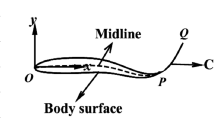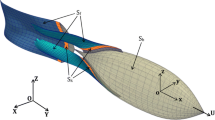Abstract
The variable flexibility of a fish body is believed to play a significant role in improving swimming performance. To explore the effect of non-uniform flexibility on the motion performance of fish under biologically relevant conditions, we set up three different flexible distribution modes for a semi-free filament and compared the motion performance of different flexible distribution modes through numerical simulations. The filament is located in the wake of the front flapping foil; it can swing adaptively in the lateral direction according to the flow situation of the surrounding fluid and finally reach a stable position. The results show that the motion state of the filament will alter with a change in the flexibility of the filament, from moving in the vortex street to moving on the side of the vortex street. In the Bénard-von Kármán (BvK) vortex streets, the drag coefficient of the filament increases as the flexibility of the filament increases, and the value of the drag coefficient is at a minimum when the flexibility of the filament increases linearly along the length of the filament. Further investigation indicates that at 85%–90% of the filament length (starting from the leading edge), the flexibility of the filament begins to increase significantly, and the filament can obtain its best propulsion performance. The results of this work provide new insights into the role of non-uniform flexibility during the process of fish movement and provide a valuable reference for the design of bionic underwater vehicles.
Graphical Abstract











Similar content being viewed by others
References
Yu, Y., Guan, Z.: Learning from bat: aerodynamics of actively morphing wing. Theor. Appl. Mech. Lett. 5, 13–15 (2015)
Gray, J.: Studies in animal locomotion. VI. The propulsive powers of the dolphin. J. Exp. Biol. 13, 92–199 (1936)
Iverson, D., Rahimpour, M., Lee, W., et al.: Effect of chordwise flexibility on propulsive performance of high inertia oscillating-foils. J. Fluids Struct. 91, 102750 (2019)
Zhu, X., He, G., Zhang, X.: How flexibility affects the wake symmetry properties of a self-propelled plunging foil. J. Fluid Mech. 751, 164–183 (2014)
Toshiyuki, N., Ryusuke, N., Shinobu, K., et al.: A simulation-based study on longitudinal gust response of flexible flapping wings. Acta. Mech. Sin. 34, 1048–1060 (2018)
Chao, L.M., Pan, G., Cao, Y.H., et al.: On the propulsive performance of a pitching foil with chord-wise flexibility at the high Strouhal number. J. Fluids Struct. 82, 610–618 (2018)
Anevlavi, D.E., Karperaki, A.E., Belibassakis, K.A., et al.: A non-linear BEM–FEM coupled scheme for the performance of flexible flapping-foil thrusters. J. Mar. Sci. Eng. 8, 1 (2020)
Liu, W., Li, N., Zhang, Z., et al.: Study on hydrodynamic force and propulsive efficiency of flexible flapping foils. J. Harbin Inst. Technol. 50, 192–198 (2018)
Fu, J., Liu, X., Shyy, W., et al.: Effects of flexibility and aspect ratio on the aerodynamic performance of flapping wings. Bioinspir. Biomim. 13, 3 (2018)
Wood, R.J.: Effect of flexural and torsional wing flexibility on lift generation in hoverfly flight. Integr. Comp. Biol. 51, 142–150 (2011)
Song, J., Luo, H., Hedrick, T.L.: Wing-pitching mechanism of hovering Ruby-throated hummingbirds. Bioinspir. Biomim. 10, 016007 (2015)
Lucas, K.N., Johnson, N., Beaulieu, W.T., et al.: Bending rules for animal propulsion. Nat. Commun. 5, 3293 (2014)
McHenry, M.J., Pell, C.A., Long, J.H.: Mechanical control of swimming speed: stiffness and axial wave form in undulating fish models. J. Exp. Biol. 198, 2293–2305 (1995)
John, Long: Muscles, elastic energy, and the dynamics of body stiffness in swimming eels. Am. Zool. 38, 771–792 (1998)
Lucas, K.N., Thornycroft, P.J., Gemmell, B.J., et al.: Effects of non-uniform stiffness on the swimming performance of a passively-flexing, fish-like foil model. Bioinspir. Biomim. 10, 056019 (2015)
Peng, Z., Elfring, G.J., Pak, O.S.: Maximizing propulsive thrust of a driven filament at low Reynolds number via variable flexibility. Soft Matter 13, 2339–2347 (2017)
Fernandez-Prats, R.: Effect of chordwise flexibility on pitching foil propulsion in a uniform current. Ocean Eng. 145, 24–33 (2017)
Peskin, C.S.: The immersed boundary method. Acta Numer. 11, 479–517 (2003)
Lin, X.J., He, G.Y., He, X.Y., et al.: Dynamic response of a semi-free flexible filament in the wake of a flapping foil. J. Fluids Struct. 83, 40–53 (2018)
Godoy-Diana, R., Aider, J.L., Wesfreid, J.E.: Transitions in the wake of a flapping foil. Phys. Rev. E 77, 016308 (2008)
Weihs, D.: Hydromechanics of fish schooling. Nature 241, 290–291 (1973)
Zhu, L.D., Peskin, C.S.: Simulation of a flapping flexible filament in a flowing soap film by the immersed boundary method. J. Comput. Phys. 179, 452–468 (2002)
Su, S.W., Lai, M.C., Lin, C.A.: An immersed boundary technique for simulating complex flows with rigid boundary. Comput. Fluids 36, 313–324 (2007)
Zhu, L.D.: Interaction of two tandem deformable bodies in a viscous incompressible flow. J. Fluid Mech. 635, 455–475 (2009)
He, G.Y., Wang, Q., Zhang, X., et al.: Numerical analysis on transitions and symmetry-breaking in the wake of a flapping foil. Acta. Mech. Sin. 28, 1551–1556 (2012)
Moore, M.N.J.: Torsional spring is the optimal flexibility arrangement for thrust production of a flapping wing. Phys. Fluids 27, 091701 (2015)
Godoy-Diana, R., Marais, C., Aider, J.L., et al.: A model for the symmetry breaking of the reverse Bénard–von Kármán vortex street produced by a flapping foil. J. Fluid Mech. 622, 23–32 (2009)
Combes, S.A., Daniel, T.L.: Flexural stiffness in insect wings: II Spatial distribution and dynamic wing bending. J. Exp. Biol. 206, 2989–2997 (2003)
Acknowledgements
This work was supported by the National Natural Science Foundation of China (Grants 11862017, 11462015 and 61963029).
Author information
Authors and Affiliations
Corresponding author
Additional information
Executive Editor: Guo-Wei He
Rights and permissions
About this article
Cite this article
Liu, L., He, G., He, X. et al. Numerical study on the effects of a semi-free and non-uniform flexible filament in different vortex streets. Acta Mech. Sin. 37, 929–937 (2021). https://doi.org/10.1007/s10409-021-01073-3
Received:
Revised:
Accepted:
Published:
Issue Date:
DOI: https://doi.org/10.1007/s10409-021-01073-3




